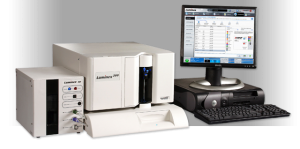Description of the Resource
First reported in 1977, the use of flow cytometry for analysis of bead-based immunoassays has expanded in recent years. The ability of flow cytometry to discriminate between particles on the basis of color or size has permitted multiplexed analysis with different bead populations enabling investigators to perform multiple discrete assays in a single tube with the same sample at the same time. The Luminex system is a bench-top flow cytometer with two low-power laser beams, which allows the user to perform simultaneously up to 100 tests in a single sample. A 635-nm diode laser is used to excite the red and infrared classifier fluorochromes that are contained in the microspheres, and a 532-nm frequency doubling Nd-YAG laser is employed to excite the orange reporter fluorochrome phycoerythrin (PE). One hundred bead sets can be detected because each set is impregnated with a unique ratio of red and infrared dyes. Antibodies, antigens, or oligonucleotides primers can be coupled to the beads to create an immunoassay, or an oligonucleotide hybridization assay. The secondary antibody or PCR product is biotinylated, and Streptavidin-PE is used as the reporter. Theoretically, with 100 bead sets, 100 analytes can be detected in a single sample. This methodology has already been used for the simultaneous determination of numerous human and NHP cytokines, single nucleotide polymorphism genotyping, and nuclear receptor interaction.
 Since 2011 the ICL has participated in a total of eight EQAPOL’s External Proficiency (EP) programs. The EQAPOL (External Quality Assurance Program Oversight Laboratory) at Duke University is supported by the Division of AIDS, NIAID, and its goal is to assess factors contributing to variability in multiplex human cytokine assays. The ICL has ranked in the top 10% of 40 international laboratories in each EP program.
Since 2011 the ICL has participated in a total of eight EQAPOL’s External Proficiency (EP) programs. The EQAPOL (External Quality Assurance Program Oversight Laboratory) at Duke University is supported by the Division of AIDS, NIAID, and its goal is to assess factors contributing to variability in multiplex human cytokine assays. The ICL has ranked in the top 10% of 40 international laboratories in each EP program.
The ICL has two Luminex with xMAP (multi-analyte platform) technology systems: a Luminex100 and a Luminex200. These instruments are available for the detection of cytokines, hormones, antigen, and antibodies in NHP body fluids such as serum, plasma, saliva, cerebrospinal fluid, vaginal and rectal swabs, gingival crevicular fluids, and tissue lysates.
Fees:
Fees are based on number of analytes, samples, and duplicates. The document below is a guide for obtaining an estimate. The final estimate will be developed by the ICL after communication with the user.
Protocols:
- Protocol for collection of serum or plasma for Luminex assays (PDF)
- Protocol for collection of vaginal samples for Luminex assays (PDF)
- Elution of cytokines from GCF strips (PDF)
- Elution of cytokines from vaginal swabs (PDF)
Resources: